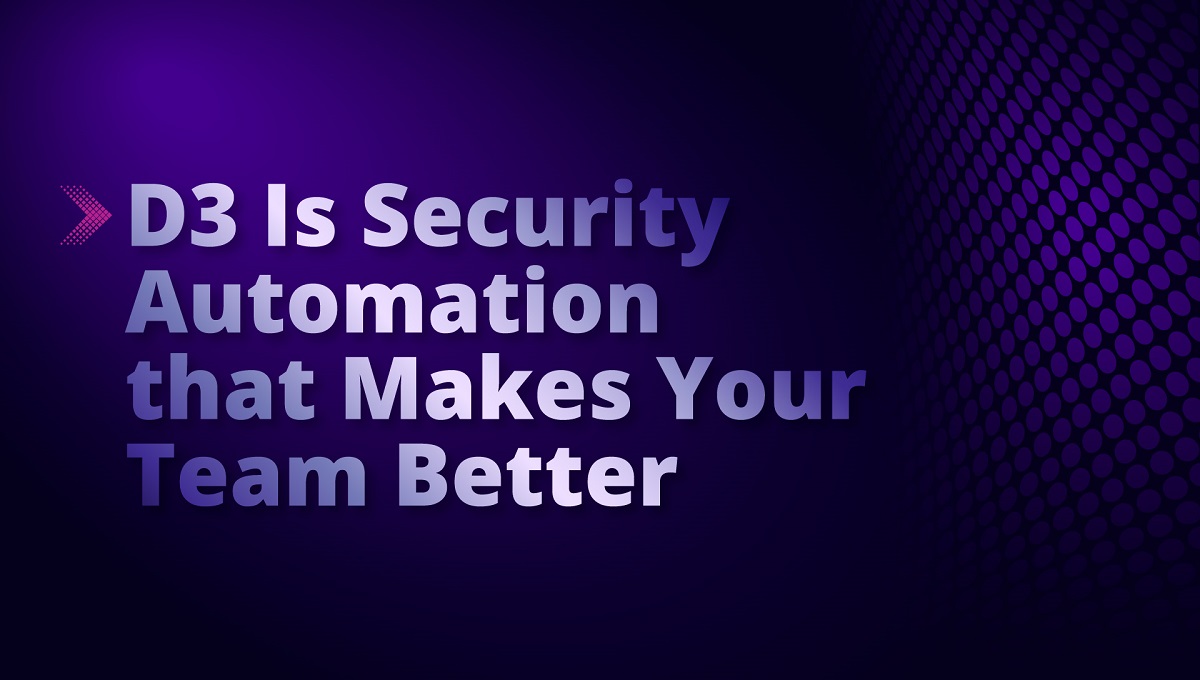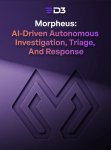Who do you want running your security operations: robots or cyborgs?
At D3, we’re on team cyborg. We see automation as a way to make human practitioners more effective, not replace them entirely. Let’s be clear: security analysts don’t need our help to be good at their jobs. Automation just needs to clear away the obstacles that clog up their time and prevent them from working at the level of their abilities.
Even if the robot path sounds appealing, we think most companies will end up on team cyborg. Security leaders know how hard it can be to hire and train qualified people, so it’s rare that companies are looking to slash the size of their security team. There’s always a lot more to do, if only there was the necessary time and resources.
Alert volume is one of the biggest problems for security teams, so why aren’t more automation vendors trying to solve it?
That’s why we prioritize people-focused automation. Simply put, it’s technology that makes your team better at security operations. Importantly, D3 achieves this alongside whatever security tools you prefer. After all, is a vendor really making your team better if you have to give up your carefully curated stack and replace it with their monolithic suite?
In this article, we’ll get specific about how D3 makes security practitioners more effective, drilling down on three specific areas where our customers see the biggest improvements.
Spending More Time on Higher-Quality Alerts Makes Your Team Better
Alert volume is one of the biggest problems for security teams, so why aren’t more automation vendors trying to solve it? The short answer: because it’s really hard. We’ve never shied away from a challenge, though, so we’ve made reducing the number of alerts that security teams have to handle a core component of our offering.
We do this by automating not just at the incident level, but also at the event level, via our Event Pipeline. Incoming alerts enter our system as events, which are deduplicated, normalized, and triaged by the Event Pipeline. This means that organizations can confidently dismiss most alerts before they require human attention, based on fully customizable criteria.
Even if you aren’t ready for automated dismissal, your team will be working off high-fidelity incident records that have been automatically assembled, not sifting through endless low-fidelity alerts. This gives your team more time to spend on real threats, armed with rich contextual data. That’s time that they used to spend chasing false positives and running monotonous reputation checks on artifacts.
No matter how good your team is, they will perform better with more time to spend on important investigations.
Less Administrative Work Makes Your Team Better
Call us crazy, but we think security teams perform best when they can focus on security work. Unfortunately, security operations come with a lot of important administrative tasks. Investigators need to track their actions and share notes with collaborators, reports need to be written after important incidents, and executives need visibility into how the SOC is operating.
D3 prioritizes the automation of these important aspects, keeping your team concentrated on doing what they do best. D3 offers a seamless connection between playbooks and the incident workspace, so that all relevant information gathered on an incident is automatically collected, written up as a summary by an integrated large language model (LLM), and displayed for investigators. This is hugely valuable because D3 draws information from all integrated tools, which gives the automated summaries the ability to connect dots that are not present in a detection tool’s alert.
D3 can also automatically assemble reports and distribute them to stakeholders. These executive reports are laid out in a professional-looking template and include a high-level summary, investigation timeline, malicious artifacts, and more. If users want to make edits to the report, they can also download it as a Word file before distributing. MSSPs can even customize the template of these reports with their own branding, making them an attractive service to provide customers.
In addition to information collection and distribution, there’s the whole matter of making the SOC operate properly on a technical level. With automation, a lot of that comes down to building, testing, and maintaining integrations. Integrations are simultaneously one of security automation’s biggest assets and—if not handled correctly—one of its biggest headaches. Making dozens of tools work together seamlessly without errors is no small task, which is why we don’t want to burden your security team with it. D3 takes the entirety of integration management off of your plate, with a dedicated team that studies hundreds of tools to develop and maintain the best possible integrations with our platform. All you have to do is drop the integrations into your playbooks.
This frees up the time your team would otherwise have to spend wrestling with integrations to translate data to fit required formats, identifying error patterns, monitoring vendor APIs for updates, and performing all of the other time-wasting tasks that come with managing integrations.
Faster and More Effective Actions Make Your Team Better
The core promise of automation has always been to enable rapid action against threats from a single interface, instead of manually moving from tool to tool to coordinate incident response processes. When you think about security automation, these are probably the capabilities that come to mind.
In addition to event-level automation and high-quality integrations, which we’ve already covered, playbooks are an important way that security automation tools enable faster actions. However, there are two ways that some automation tools cannibalize the gains their playbooks are meant to offer.
One is by making it difficult to build, test, edit, and deploy playbooks. As with our integrations, D3 wants to minimize the burden of managing playbooks. That’s why we have a codeless playbook editor that is easy to use, with hundreds of prebuilt utility commands for important actions like retrieving users, artifacts, and events. Users can test their playbooks directly from the editor, to easily find errors before publishing.
The second potential pitfall is when playbooks are too limited to maximize the benefits for users, which slows them down or requires them to do additional work. D3 overcomes this with advanced playbook capabilities that support flexibility, efficiency, and reliability. For example, D3 playbooks can run tasks in parallel to reduce processing time, run looping tasks to check back for new information at a set interval, and schedule proactive tasks like threat hunting.
D3 also has nested playbooks, which are playbooks that can be saved as single playbook blocks to be reused, instead of users having to rebuild common sequences from scratch each time. For example, a sequence to enrich an incident with data on the sender of an email can be saved as a nested playbook and then dropped into any playbooks that deal with suspicious emails. This isn’t just a time-saver. Nested playbooks and extensive utility commands simplify playbook design, creating fewer potential points of failure.
Having powerful playbooks means that your team can do more within their automation platform, automating complex sequences and weighing in at key decision points, instead of having to figure out workarounds for the limitations of the automation tool.
Bring People-Focused Automation to Your SOC with D3
There’s a place for the “robots” in security operations. As you can see, there are lots of things that D3 automates completely. But it’s always in the service of empowering the human user.
People-focused automation enables better decision-making, because it puts all the information where you need it. It makes your organization more secure, by clearing out the noise and freeing up time for deep investigations of real threats. It keeps your security experts focused on security, by taking administrative tasks off their plates. And it makes your team faster, because automation turns their decisions into orchestrated actions across the environment.
Get a demo with our security automation experts to learn more about how D3 can help your team be even better at keeping your organization secure.




